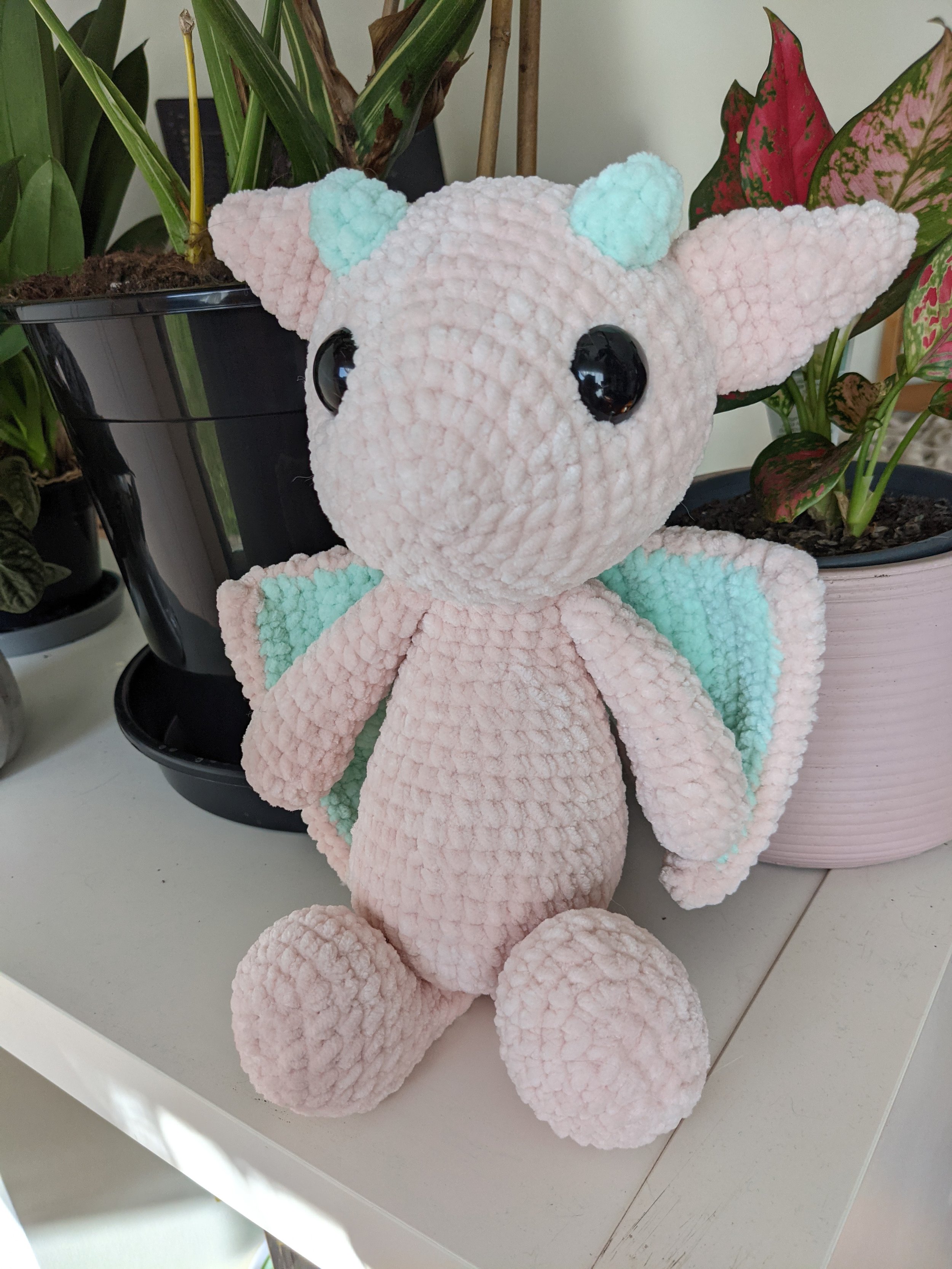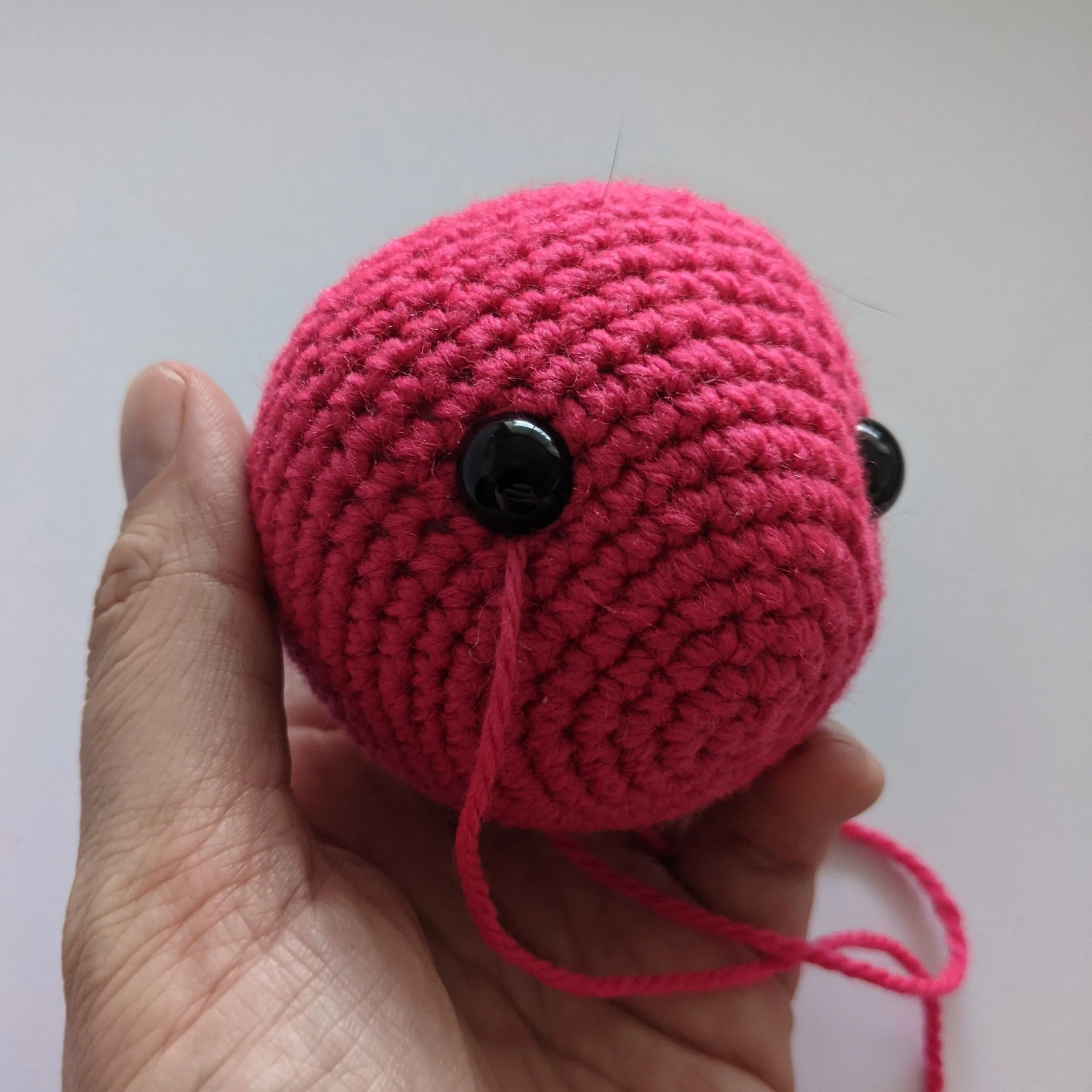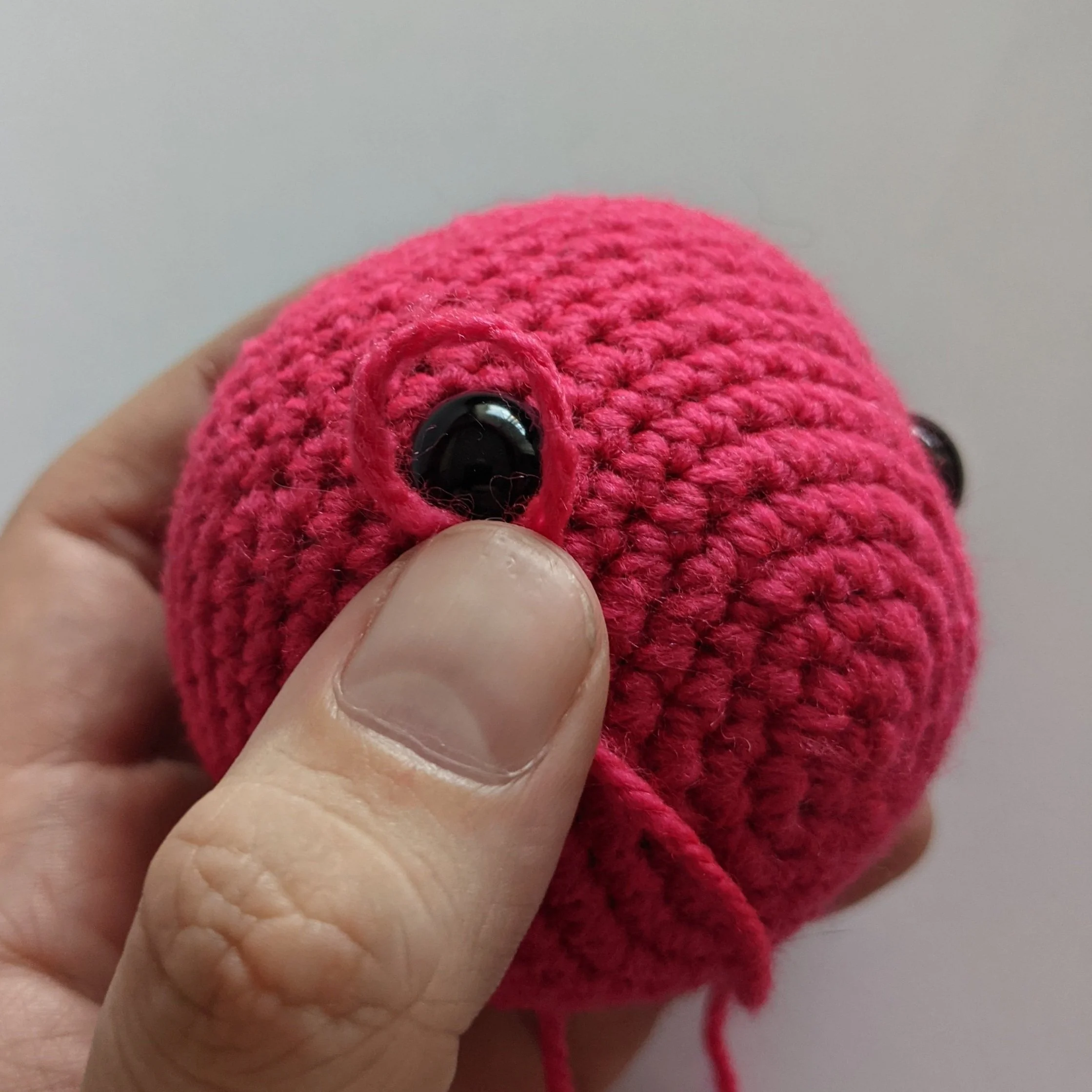
A pattern worth Dragon yourself out of bed for.
Dandelion the Dragon Crochet Pattern
Before you start:
This pattern is completely written however is waiting on pictures of the step-by-step process, if you have any problems with the pattern please reach out and let me know and I’ll prioritise getting that step photographed!
While this dragon is generally made with chenille / velvety yarn and a larger hook, you can make this using standard acrylic yarn as well and a smaller hook.
This Dragon tends to need 1 an a bit balls of the Himalaya dolphin baby and the Hobbii Honey Bunny unfortunately in the primary colour, the wings make her somewhat yarn hungry.
The smaller dragons are made with 8ply acrylic yarn; I personally use the Marvel brand from Spotlight stores in Australia
The larger soft dragons are made with Himalaya dolphin, and a 4.5mm hook.
A good alternative is Hobbii’s Honey Bunny yarn
Safety eyes are not suitable for small children as they may pose a choking hazard, if finished product is intended for a child please do not use safety eyes here and use one of the following insted:
Using 100% Mercerised cotton in 4ply & a 1.5mm hook (a 2 - 2.5mm hook will be fine here too depending on personal preference)
Crochet 8 HDC into a Magic Ring
Crochet 2 HDC into each stitch around (16 stitches)
You can use either SC or DC for either row depending on how big you want the eyes to be. I personally like to then loop some white through some stitches to make highlights, but this is personal preference.
Felt and/or felting on eyes using a felting tool
The indent on the eyes is created by looping scrap acyrlic yarn around them and pulling inwards, this step will be detailed below but is entirely optional.
A Glossary of Terms:
Pattern is written in US Terminology unless otherwise specified
Ch —> Chain
Slst —> Slip Stitch
SC —> Single Crochet
HDC —> Half-double Crochet
DC —> Double Crochet
TC —> Triple Crochet
INC —> Increase (Work 2 stitches into the same stitch to add one to the overall count)
DEC —> Decrease (crochet two stitches together to remove one fro the overall count)
MR —> Magic Ring (Work stitches into a tight circle)
This pattern is worked in the round, this means please don’t slip stitch at the end of the row to join, continue on in a spiral.
You will need:
4.5 mm crochet hook
Yarn needle
Himalaya dolphin baby - 1.5 entire balls in base colour, scraps in secondary colour.
15 - 18 mm safety eyes
Head
Worked front to back
Attach the eyes in between rows 9 and 10 before closing off, approx 11-12 stitches apart.
|
Row |
Instructions |
Final stitch count |
|
1 |
Magic Ring 6 |
(6) |
|
2 |
INC Around |
(12) |
|
3 |
(SC1, INC) x6 |
(18) |
|
4 |
(SC1, INC, SC1) x6 |
(24) |
|
5 |
(SC3, INC) x6 |
(30) |
|
6 |
(SC2, INC, SC2) x6 |
(36) |
|
7 - 8 |
SC in each stitch around |
(36) |
|
9 |
(SC5, INC) x6 |
(42) |
|
10 - 11 |
SC in each stitch around |
(42) |
|
12 |
(SC3, INC, SC3) x6 |
(48) |
|
13 - 17 |
SC in each stitch around |
(48) |
|
18 |
(SC3, DEC, SC3) x6 |
(42) |
|
19 |
(SC5, DEC) x6 |
(36) |
|
20 |
(SC2, DEC, SC2) x6 |
(30) |
|
21 |
(SC3, DEC) x6 |
(24) |
|
22 |
(SC1, DEC, SC1) x6 |
(18) |
|
23 |
(SC1, DEC) x6 |
(12) |
|
24 |
DEC Around |
(6) |
Indenting the Eyes
On your finished head piece, take another long piece of yarn - if you used the himalaya dolphin baby yarn, ideally you want to use an acrylic yarn in a similar colour for this, the himalaya may snap if you use it. Colour match is not important, if you don’t have a close one use whatever you’d like for this - the himalaya brown rabbit I used pumpkin coloured thread, there’s an image down the bottom of the section, you shouldn’t be able to see the thread at all when you’re done.
Attach thread to your yarn needle and pass the yarn through the stitch closest to the eye on the inside bottom corner, through to the opposite eyes bottom inside corner.
Pull thread through until you have even tails on either side
4. Make a loop with the tail and loop around the eye twice, pull loop tight so you cannot see the loop anymore on the eye and have the tail back where it started in the bottom inside corner - do this on both eyes.
7. Take the two tails, and pull them tightly until the eyes are indented to where you want them.
8. Knot the ends over at least one stitch to anchor them in place, ensure you don’t use a granny knot here or it will slowly slip out.
9. Leave the tails free, you can stuff them into the body when it’s completed and attached, you may want to weave the ends into some of the stitches on the bottom of the head that will be covered by the body if this toy is expected to be thrown around a fair bit to secure them a little more.
5. Pass thread now back through the stitch closest to the bottom inside of the eye, but this time draw the thread down to the bottom center of the head piece - this part of the head will be covered by the body.
6. Ensure when you do the other eye you pass the thread through to the adjacent stitch, you will need the tails in different close stitches to each other to anchor them, otherwise when you pull the threads they won’t stay where you pull.
Do I look familiar? The dragon, triceratops and the spikey dino all use the same base, they’re triplets!
The Bunny draws a similar shapes, but has a different shaped head.
Body
|
Row |
Instructions |
Final stitch count |
|
1 |
Magic Ring 6 |
(6) |
|
2 |
INC Around |
(12) |
|
3 |
(SC1, INC) x6 |
(18) |
|
4 |
(SC1, INC, SC1) x6 |
(24) |
|
5 |
(SC3, INC) x6 |
(30) |
|
6 |
(SC2, INC, SC2) x6 |
(36) |
|
7 |
(SC5, INC) x6 |
(42) |
|
8 - 11 |
SC Around |
(42) |
|
12 |
(SC5, DEC) x6 |
(36) |
|
13 |
SC Around |
(36) |
|
14 |
(SC5, DEC, SC5) x6 |
(33) |
|
15 |
SC Around |
(33) |
|
16 |
(SC9, DEC) x3 |
(30) |
|
17 |
SC Around |
(30) |
|
18 |
(SC3, DEC) x6 |
(24) |
|
19 |
SC Around |
(24) |
|
20 |
(SC1, DEC, SC1) x6 |
(18) |
|
21 - 24 |
SC Around |
Tail
|
Row |
Instructions |
Final stitch count |
|
1 |
Magic Ring 4 |
(4) |
|
2 |
(SC1, INC) x2 |
(6) |
|
3 |
SC Around |
(6) |
|
4 |
SC1, INC, SC2, INC, SC1 |
(8) |
|
5 |
SC Around |
(8) |
|
6 |
(SC1, INC) x4 |
(12) |
|
7 |
SC Around |
(12) |
|
8 |
(SC3, INC) x3 |
(15) |
|
9 |
SC Around |
(15) |
|
10 |
SC2, (INC, SC4) x2, INC, SC2 |
(18) |
|
11 |
(SC5, INC) x3 |
(21) |
Arms (Make Two)
|
Row |
Instructions |
Final stitch count |
|
1 |
Magic Ring 6 |
(6) |
|
2 |
INC Around |
(12) |
|
3 – 5 |
SC Around |
(12) |
|
6 |
DEC x2, SC8 |
(10) |
|
7 - 14 |
SC Around |
(10) |
Legs (Make 2)
The legs are worked in a round that is started from a chain, this is done by crocheting along the chain as you normally would, and then going around and crocheting along the back of the chain as well to create an oval shape instead of the circle you’d usually start with.
This is done to create a longer foot - if you’re not comfortable doing this and don’t mind a rounder foot, you can instead subsitite round 1 for a MR6, then INC in each stitch around to create your own 12start.
|
Row |
Instructions |
Final stitch count |
|
1 |
Chain 5, 2SC in second chain from hook, SC1 in next 2 Chains, 2SC in final chain.
Working along the
Back of the chain now, you should have 4 backs to work
into.
|
(12) |
|
2 |
(SC4, INC2) x2 |
(16) |
|
3 |
(SC5, INC, SC, INC) x2 |
(20) |
|
4 |
(SC6, INC, SC2, INC) x2 |
(24) |
|
5- 6 |
SC Around |
(24) |
|
7 |
(SC10, DEC) x2 |
(22) |
|
8 |
SC6, DEC x4, SC8 |
(18) |
|
9 |
SC5, DEC x3, SC7 |
(15) |
|
10 |
SC4, DEC, SC, DEC, SC6 |
(13) |
|
11 - 14 |
SC Around |
(13) |
Horns
Make horns in secondary highlight colour.
|
Row |
Instructions |
Final Stitch Count |
|
1 |
SC4 into a Magic Ring |
(4) |
|
2 |
(SC, INC) x2 |
(6) |
|
3 |
(SC, INC, SC) x2 |
(8) |
Ears
Make Ears in primary body colour.
|
Row |
Instructions |
Final Stitch Count |
|
1 |
SC4 into a Magic Ring |
(4) |
|
2 |
INC in each stitch around |
(8) |
|
3 |
SC in each stitch around |
(8) |
|
4 |
(SC, INC) x4 |
(12) |
|
5 |
SC in each stitch around |
(12) |
|
6 |
(SC, INC, SC) x4 |
(16) |
|
7 - 8 |
SC in each stitch around |
(16) |
|
9 |
(SC, DEC, SC) x4 |
(12) |
Wings: Made in 2 parts each.
The wings are made in two parts per wing, the inner patch, usually completed in the secondary highlight colour - and the outer patch, usually completed in the Primary body colour. These are then whip stitched together to form the one wing piece.
I would highly reccommend making all four pieces before sewing, the wings will need to be sewn as mirror images of each other, don’t make two left wings by mistake!
Be aware of the positioning of the increases here, the increases should happen on the same side each time, otherwise you won’t create the triangle shape of the wings. The pattern looks more troublesome than it is, increase every row on the same side each time until you get to size and don’t decrease on the last row.
Worked in ROWS not in the round.
Wing (Inner Piece, secondary colour)
|
Row |
Instructions |
Final Stitch Count |
|
1 |
Chain 7, starting in second chain from the hook SC 6. Ch1 and turn. |
(6) |
|
2 |
SC 5, INC. Ch1 and turn. |
(7) |
|
3 |
INC, SC 6. Ch1 and turn. |
(8) |
|
4 |
SC 7, INC. Ch1 and turn. |
(9) |
|
5 |
INC, SC 8. Ch1 and turn. |
(10) |
|
6 |
SC 9, INC. Ch1 and turn. |
(11) |
|
7 |
INC, SC 10. Ch1 and turn. |
(12) |
|
8 |
SC 11, INC. Ch1 and turn. |
(13) |
|
9 |
INC, SC 12. Ch1 and turn. |
(14) |
|
10 |
SC 13, INC. Ch1 and turn. |
(15) |
|
11 |
INC, SC 14. Ch1 and turn. |
(16) |
|
12 |
SC 16. |
(16) |
Wing (Outer Piece, Primary colour)
|
Row |
Instructions |
Final Stitch Count |
|
1 |
Chain 9, starting in second chain from the hook SC 8. Ch1 and turn. |
(6) |
|
2 |
SC 5, INC. Ch1 and turn. |
(7) |
|
3 |
INC, SC 6. Ch1 and turn. |
(8) |
|
4 |
SC 7, INC. Ch1 and turn. |
(9) |
|
5 |
INC, SC 8. Ch1 and turn. |
(10) |
|
6 |
SC 9, INC. Ch1 and turn. |
(11) |
|
7 |
INC, SC 10. Ch1 and turn. |
(12) |
|
8 |
SC 11, INC. Ch1 and turn. |
(13) |
|
9 |
INC, SC 12. Ch1 and turn. |
(14) |
|
10 |
SC 13, INC. Ch1 and turn. |
(15) |
|
11 |
INC, SC 14. Ch1 and turn. |
(16) |
|
12 |
SC 15, INC. Ch1 and turn. |
(17) |
|
13 |
INC, SC 16. Ch1 and turn. |
(18) |
|
14 |
SC 17, INC. Ch1 and turn. |
(19) |
|
15 |
INC, SC 18. Ch1 and turn. |
(20) |
|
16 |
SC 20. |
(20) |
You should have two pieces for each wing as above - the inner piece should be smaller than the outer piece.
When attaching the two, because there’s a size difference, you won’t be able to attach stitch-for-stitch. Regardless every stitch should have an attachment point for overall neatness - Attach extra outer piece stitches at the outside corners (ie: 3-4 stitches into the one inner piece stitch) to make the wings more curly at the ends.
If you’re using chenille yarn here, a plastic yarn needle will shred the tail less than the metal ones will, making the tail more likely to go all the way around without snapping.
Attach with either colour, I tend to prefer to use the outer wing colour to attach but you can use either.
Attaching Everything
Rules for attaching things:
Pin first, always.
Don’t have pins? Use crochet or knitting needles as pins, your stitches have gaps in them no matter how tighly you crochet. Use Safety pins, stitch markers, chopsticks, toothpicks….
If you’re not sure you’ve pinned everything in the right spot, have someone stand further away from you holding it, or place it on a table and walk a couple meters away to look at it. Sometimes Distance is the perspective you need to notice that one arm is higher than the other etc
The direction of your needle should always go inside to the outside. Never pass the sewing thread from the outside in.
Try both ways! If you go from outside —> Inside, you’ll be able to see the thread on the outside of the work, by passing inside —> Outside you hide the bulk of it inside the toy.
Knot and wave every thread to lock it in place, even if it doesn’t look like it should be a super important one.
If you’re using Chenille yarn, you’ll find plastic yarn needles shred the yarn a lot less, metal yarn needles tend to shred it a bit, and the yarn can be hard to attach with.
If needs be, a closely coloured acrylic/cotton will attach just fine, you can generally hardly see the attaching yarn.
Photo instructions to come :( See below visual examples for now.
Pictured: Evidence of pattern testing completed by his lordship, Merlin.




























